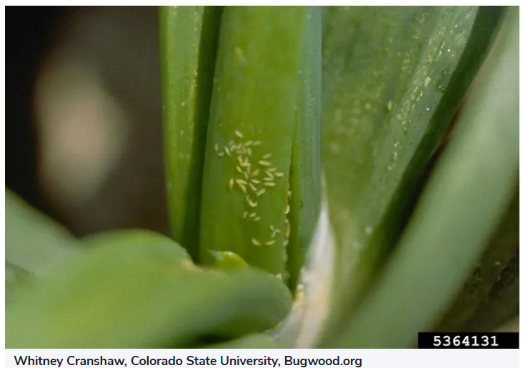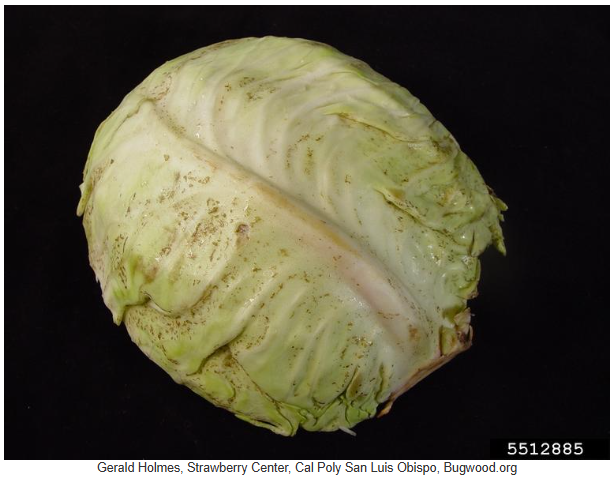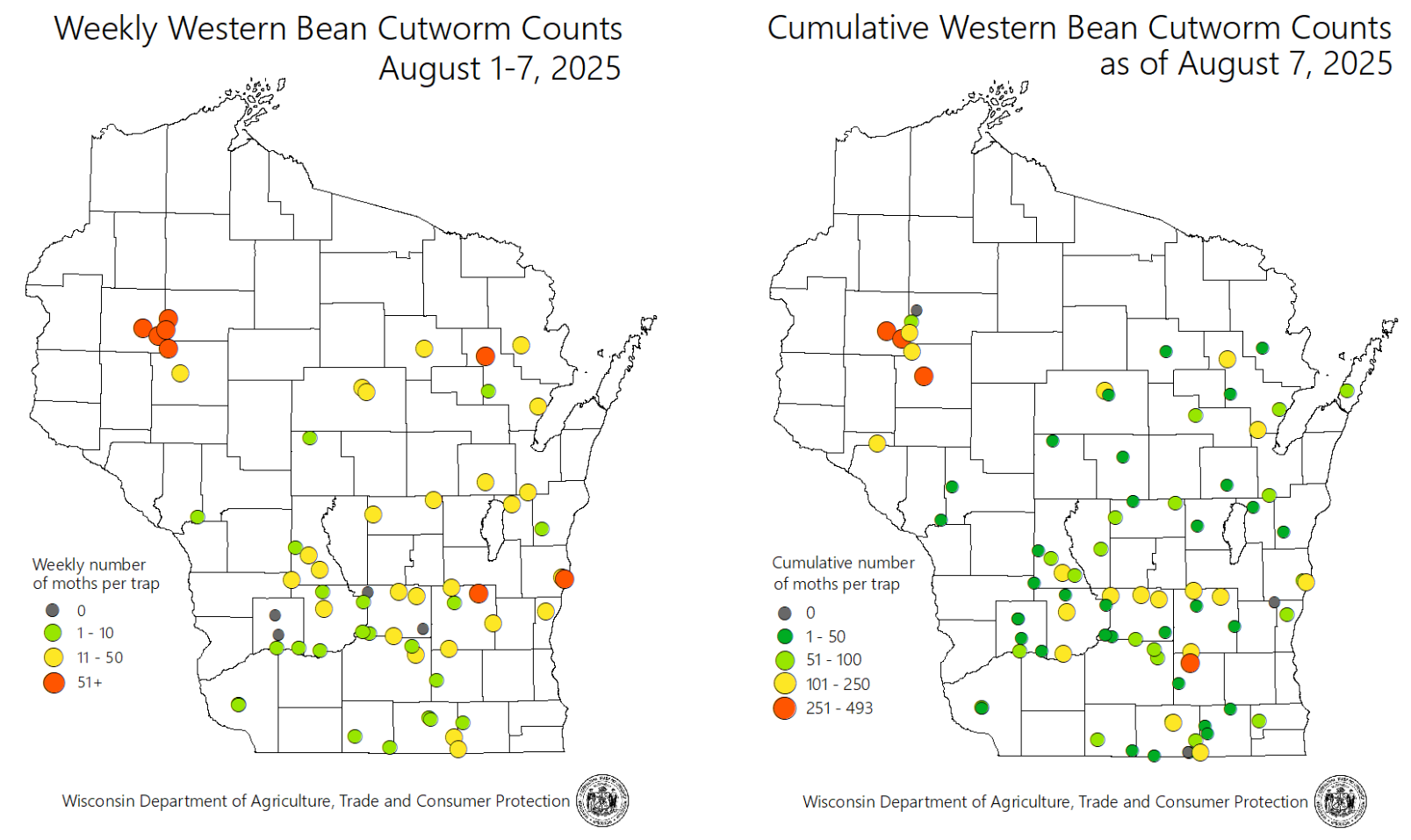
In This Issue:
- Onion thrips updates and management
- Western bean cutworm updates and management
- Disease forecasting updates for potato early blight and late blight
- Cucurbit downy mildew, cucurbit powdery mildew updates and management
- Onion Stemphylium updates and management
Vegetable Insect Update – Russell L. Groves, Professor, UW-Madison, Department of Entomology, 608-262-3229 (office), (608) 698-2434 (cell), e-mail: rgroves@wisc.edu. Vegetable Entomology Webpage: https://vegento.russell.wisc.edu/
 Onion thrips – (https://vegento.russell.wisc.edu/pests/onion-thrips/) With recent warm temperatures and dry conditions across central and southern Wisconsin, it is important to continue scouting for onion thrips in susceptible onion and cabbage crops. Heavy rains across the state today (August 10), however, may slow larval populations. Although regions of the state have received good, patterned rainfall through much of the summer, thrips populations can be expected to build with warm temperatures and the recent dry weather. Forecast temperatures by mid-week are back into the high 80’s with fair weather conditions.
Onion thrips – (https://vegento.russell.wisc.edu/pests/onion-thrips/) With recent warm temperatures and dry conditions across central and southern Wisconsin, it is important to continue scouting for onion thrips in susceptible onion and cabbage crops. Heavy rains across the state today (August 10), however, may slow larval populations. Although regions of the state have received good, patterned rainfall through much of the summer, thrips populations can be expected to build with warm temperatures and the recent dry weather. Forecast temperatures by mid-week are back into the high 80’s with fair weather conditions.
Monitor plants weekly, and scout plants on across several positions within fields edges as thrips can be aggregated or patchy in their distribution. 3 thrips per onion leaf is a widely accepted threshold for chemical treatment. Some tolerant varieties such as Snow White and Vega can handle over 50 thrips per plant without significant damage.

Control through insecticides can be challenging because immature thrips are often protected location in leaf axial of plants. Direct sprays down the center of plants. Foliar insecticides should be applied in sufficient water with a spray additive (mild penetrant) to achieve contact with leaves in the areas where larval (immature) thrips feed on the plant. Alternate with two or more materials to minimize potential for resistance. Effect control options for conventional producers include spinosad (Conserve), spinetoram (Radiant), abamectin (Agri-Mek), spirotetramat (Movento), methomyl (Lannate), tolfenpyrad (Torac) and cyantraniliprole (Exirel). Organic producers can use spinosad (Entrust), azadirachtin (Aza-Direct), Chromobacterium spp. (Grandevo), pyrethrins (Azera, Pyganic), and Burkholderia (Venerate SC).

Since thrips prefer tight spaces, winter storage cabbage varieties with extremely dense heads are most susceptible to damage. Thrips are often found several layers deep within developing cabbage heads. Heavy thrips buildup may cause the cabbage head to become distorted. Varieties in onion differ in terms of thrips susceptibility, and red onions are particularly susceptible, while Spanish yellow onions tend to be somewhat more tolerant/resistant. Cultivars with leaves tightly held together are more susceptible to thrips damage, while cultivars with more open grown, circular leaf structure, and glossy foliage suffer less damage.
Onion thrips overwinter in legume and grain fields and along weedy field edges. Females can reproduce without mating and lay eggs beneath the leaf’s surface. Eggs hatch after 5-10 days, and nymphs are full grown within 15-30 days. Development of the last two nymphal stages occurs in the soil, without feeding. After the fourth molt, adult female thrips return to the plant. Thrips produce 5-8 generations per year, and outbreaks are most frequent in hot, dry weather. Because of the fast generation time of onion thrips, the successive generations of damaging thrips can be observed moving across the state from the southwest to the northeast regions of the state.
Western bean cutworm – Captures of adult western bean cutworm moths are continuing over the past 2 weeks of pheromone trapping illustrated by the Wisconsin Department of Agriculture, Trade and Consumer Protection. First flights of this moth peaked on August 1, 2025, but have continued through the first week of August, 2025. Although not a widespread insect with consistent economic loss, it is a potential problem in areas of the state where elevated captures continue.

Amanda Gevens, Professor & Extension Vegetable Pathologist, UW-Madison, Dept. of Plant Pathology, 608-575-3029, gevens@wisc.edu, Lab Website: https://vegpath.plantpath.wisc.edu/.
Current P-Day (Early Blight) and Disease Severity Value (Late Blight) Accumulations will be posted at our website and available in the weekly newsletters. Thanks to Ben Bradford, UW-Madison Entomology for supporting this effort and providing a summary reference table: https://agweather.cals.wisc.edu/thermal-models/potato. A Potato Physiological Day or P-Day value of ≥300 indicates the threshold for early blight risk and triggers preventative fungicide application. A Disease Severity Value or DSV of ≥18 indicates the threshold for late blight risk and triggers preventative fungicide application. Data from the modeling source: https://agweather.cals.wisc.edu/vdifn are used to generate these risk values in the table below. I’ve estimated early, mid-, and late planting dates by region based on communications with stakeholders. These are intended to help in determining optimum times for preventative fungicide applications to limit early and late blight in Wisconsin.
|
|
Planting Date | 50% Emergence Date | Disease Severity Values (DSVs)
through 8/9/2025 |
Potato Physiological Days (P-Days)
through 8/9/2025 |
|
| Spring Green | Early | Apr 5 | May 10 | 39 | 714 |
| Mid | Apr 18 | May 14 | 39 | 686 | |
| Late | May 12 | May 26 | 36 | 629 | |
| Arlington | Early | Apr 5 | May 10 | 31 | 715 |
| Mid | Apr 20 | May 15 | 31 | 678 | |
| Late | May 10 | May 24 | 28 | 641 | |
| Grand Marsh | Early | Apr 7 | May 11 | 37 | 697 |
| Mid | Apr 17 | May 14 | 37 | 677 | |
| Late | May 12 | May 27 | 37 | 623 | |
| Hancock | Early | Apr 10 | May 15 | 39 | 667 |
| Mid | Apr 22 | May 21 | 37 | 640 | |
| Late | May 14 | June 2 | 37 | 586 | |
| Plover | Early | Apr 14 | May 18 | 34 | 643 |
| Mid | Apr 24 | May 22 | 34 | 641 | |
| Late | May 19 | June 7 | 34 | 546 | |
| Antigo | Early | May 1 | May 24 | 34 | 607 |
| Mid | May 15 | June 1 | 34 | 567 | |
| Late | June 1 | June 15 | 29 | 480 | |
| Rhinelander | Early | May 7 | May 25 | 26 | 579 |
| Mid | May 18 | June 8 | 25 | 501 | |
| Late | June 2 | June 16 | 22 | 460 | |
Late blight of potato/tomato. I’m aware of no new reports of late blight in the US this past week. Findings thus far in potato and tomato have been confirmed as US-23 Phytophthora infestans (still sensitive to mefenoxam/metalaxyl (ie: Ridomil). Here in Wisconsin, we saw nominal accumulations of just 0-2 DSVs across WI this past week. All plantings of potatoes in Wisconsin have surpassed the Blitecast threshold of 18 DSVs and should receive preventative fungicides for the management of late blight. Please find a fungicide listing for Wisconsin potato late blight management: https://vegpath.plantpath.wisc.edu/documents/potato-late-blight-fungicides/
Early blight of potato. Accumulations of P-Days were 58-62 over the past week, with P-Day 300 thresholds met for preventative fungicide treatment in potatoes across all of Wisconsin. Lesion progression over the past few weeks has been substantial. In our untreated plots at UW-HARS, lower canopies are quite yellow with enlarged early blight lesions. This time of the year is tough for specific scouting as there are several diseases which may be at work along with natural crop tip and maturation. https://vegpath.plantpath.wisc.edu/diseases/potato-early-blight/. For Wisconsin-specific fungicide information, please refer to the Commercial Vegetable Production in Wisconsin (A3422), a guide available here: https://cropsandsoils.extension.wisc.edu/articles/2025-commercial-vegetable-production-in-wisconsin-a3422/
For custom values, please explore the UW Vegetable Disease and Insect Forecasting Network tool for P-Days and DSVs across the state (https://agweather.cals.wisc.edu/vdifn). This tool utilizes NOAA weather data. Be sure to enter your model selections and parameters, then hit the blue submit button at the bottom of the parameter boxes. Once thresholds are met for risk of early blight and/or late blight, fungicides are recommended for optimum disease control. Fungicide details can be found in the 2025 Commercial Veg. Production in WI Extension Document A3422: https://cropsandsoils.extension.wisc.edu/articles/2025-commercial-vegetable-production-in-wisconsin-a3422/
Cucurbit Downy Mildew: National cucurbit downy mildew information helps us understand the potential timing of arrival of the pathogen, Pseudoperonospora cubensis, in our region, as well as the strain type which can give us information about likely cucurbit hosts in WI – as well as best management strategies. Clade 1 downy mildew strains infect watermelon and Clade 2 strains infect cucumber. I am hosting a cucurbit (and basil) downy mildew sentinel plot at the UW Hancock Agricultural Research Station this summer. This ‘sentinel plot’ is a non-fungicide-treated collection of cucurbit plants observed weekly for disease symptoms. No downy mildew was seen on cucurbits this past week at HARS, and none reported through our UW Plant Disease Diagnostic Clinic. The basil downy mildew that I reported on July 27 at Hancock ARS has not advanced from the lower plant canopies. In this planting, we have drip tape under plastic mulch that aids in limiting canopy moisture and disease progress. Additionally, I keep an eye on the downy mildew work of Dr. Mary Hausbeck at Michigan State University and include this information as relevant to WI https://veggies.msu.edu/downy-mildew-news/. This season, Clade 2 downy mildew spores were confirmed in several MI counties and downy mildew has been confirmed in commercial cucumber fields and home garden plots in several MI counties. No new reports were posted at the Cucurbit Downy Mildew ipmPIPE website: https://cdm.ipmpipe.org/.
It’s important to use fungicides with demonstrated performance in managing downy mildew and to treat preventatively for best control. The alphabetic list below was developed by Dr. Mary Hausbeck from fungicide performance in her Michigan trials during 2021-24. Fungicides should be alternated to mitigate the development of resistance.
- Elumin + chlorothalonil or mancozeb
- Omega (Orbus) + chlorothalonil or mancozeb
- Orondis Opti (chlorothalonil is part of the premix)
- Previcur Flex + chlorothalonil or mancozeb
- Ranman + chlorothalonil or mancozeb
- Zampro + chlorothalonil or mancozeb
Cucurbit Powdery Mildew: Cucurbits have been showing signs of powdery mildew in central Wisconsin over the past week. This disease is typically caused by the fungal pathogen Podosphaera xanthii and we see it appear on most susceptible cucurbits first in mid to late July of most years. While some cucurbits can tolerate powdery mildew infection, if the disease onsets early and on a highly susceptible variety (especially those of pumpkin and winter squash), control with fungicides may be necessary. Powdery mildew can negatively impact the quality and storability of hard squashes and pumpkins and can predispose fruit to secondary infections by other fungi or bacterial soft rots. There are several fungicides with effective control of powdery mildew (list provided below from the A3422 Commercial production guide for vegetables in Wisconsin). However, cucurbit powdery mildew pathogen populations in Wisconsin have resistance to the strobilurin fungicides which include azoxystrobin, pyraclostrobin, and trifloxystrobin. In our past field trials, Quintec (quinoxyfen) was most effective in alternation and tank-mixed with chlorothalonil. For multi-pick cucurbits, it’s important to have a look at the allowable days to harvest. The images below show typical powdery mildew signs (talcum-like white spore production on foliage) and the disease cycle of powdery mildew on cucurbits.


Onion Stemphylium leaf blight is a fungal disease of alliums caused by Stemphylium vesicarium. It causes oval-shaped, tan or brown lesions on the leaves, which may appear water-soaked and darker when sporulating. These lesions can enlarge and overtake entire leaves, as well as girdle seed stems. Blighted leaves can compromise the bulb, reducing yield and leading to secondary infections. Stemphylium can be very challenging to manage once established in onion. Overall health management of onion plants is critical in reducing the time of onset of Stemphylium as weakened or damaged plants are more susceptible to infection. Damage or stress from heat, drought, insects, herbicides, or other physical causes of injury to plants should be minimized.

Primary Source: Infected plant debris
Spread: Airborne spores, often appears as a secondary infection of downy mildew lesions, herbicide or physical plant injury, and heat-stressed/drought-stressed leaves
Favorable Conditions: High humidity, moderate temperatures, excess moisture from precipitation or irrigation, high dew point
Infection & Disease Cycle. Stemphylium vesicarium overwinters in plant debris. Once temperatures warm in the spring, airborne spores called “ascospores” are released from this plant debris, infecting nearby leaves that have been wounded by other diseases (including downy mildew), insects, heat-stress, or damaging elements including weather, or chemical/mechanical injury. Subsequent lesions will produce airborne and waterborne spores called “conidia” that will travel, causing secondary infections. At the end of the cropping season, the pathogen will again overwinter in plant debris, continuing the disease cycle.
Cultural Control. Scouting regularly allows early identification of disease before significant spread and damage. The following practices can also help prevent disease development:
- Rotate away from susceptible crops ( 3-4 years)
- Maintain proper nutrition & avoid excessive nitrogen application
- Maintain proper moisture levels in the crop
- Take care with use of herbicides to avoid phytoxicity or other injury
- Destroy infested plant debris & culls
- Manage onion downy mildew
Chemical Control. For Wisconsin-specific fungicide information, refer to the Commercial Vegetable Production in Wisconsin (A3422), a guide available through the UW Extension Learning Store website. Or, for home garden fungicide recommendations, see Home Vegetable Garden Fungicides (D0062), a fact sheet available through the UW Plant Disease Diagnostic Clinic website. Always follow label directions carefully.
For commercial onion growers, the Cornell onion foliar disease “cheat sheet” may be helpful in selecting best fungicides for disease control. https://rvpadmin.cce.cornell.edu/uploads/doc_1216.pdf. It is not apparent that Wisconsin has resistance to the same classes of fungicides as characterized in NY, but resistance can develop when classes of fungicides are heavily relied upon for management of a single target pathogen. NY trials indicated that the tank-mixing of P07 fungicides (mono & di-potassium salts of phosphorous acid, potassium phosphite) with reduced-risk fungicides enhanced Stemphylium control.
In our WI fungicide efficacy trials of the past recent years, we have found the following fungicides to be most effective when used in season-long programs with alternating fungicide selection strategies: Luna Tranquility, Quadris Top, Miravis Prime, Tilt, Viathon, Switch. In our programs, we applied mancozeb or chlorothalonil in tank-mix and in alternation with the previously listed fungicides. Mancozeb should be used mid- and late season to support downy mildew control.
Resources
- Commercial Vegetable Production in Wisconsin (A3422) from the UW Extension Learning Store. This guide offers the latest recommendations for disease, insect, and weed management in Wisconsin’s most common commercial vegetable crops. Also included are lime and fertilizer recommendations as well as insect identification information and keys.
- UW Plant Disease Diagnostics Clinic. The University of Wisconsin-Madison/Extension Plant Disease Diagnostics Clinic (PDDC) provides assistance in identifying plant diseases and provides educational information on plant diseases and their control.
- Nischwitz, Claudia. 2020. “Purple Blotch and Stemphylium Leaf Blight.” 2020. https://extension.usu.edu/vegetableguide/onion/purple-blotch-stemphylium-leaf-blight.
- Swett, C.L., B.J. Aegerter, T.A. Turini, and A.I. Putman. 2019. “Purple Blotch and Stemphylium Leaf Blight / Onion and Garlic / Agriculture: Pest Management Guidelines / UC Statewide IPM Program (UC IPM).” 2019. https://ipm.ucanr.edu/agriculture/onion-and-garlic/purple-blotch-and-stemphylium-leaf-blight/.